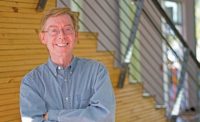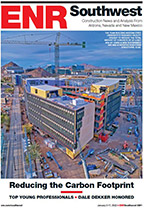Two days after the Sept. 11, 2001, terrorist attacks on the World Trade Center, structural engineer Irwin G. Cantor—guided by steel erector Bobby Stuart—walked up a darkened staircase to the 18th floor of a World Financial Center tower near Ground Zero, which his office had engineered in the 1980s. Cantor wanted to satisfy himself that a severely damaged corner column had been tied off safely.
The trek up and down 18 flights took place about a year after Cantor’s open heart surgery and diagnosis of lung cancer, but that didn’t stop him. “I kept saying to myself, ‘What the hell am I doing here?’” he recalls.
As it turned out, the column was properly tied off and didn’t fall. Fortunately, neither did Cantor, who was then just shy of 74. Afterward, he decided he’d had enough exercise for a while.
The heroics showed Cantor’s true grit—just one trait that qualifies him as a “mentsh.” The Yiddish word—spelled mensch in German—means a person of strength, integrity, decency, compassion and honor. His many fans also say he is intelligent, insightful, fair, demanding, diplomatic, innovative, generous and—last but not least—funny.
Described as a cross between celebrated engineer John A. Roebling and comedian Mel Brooks, the consummate New Yorker delivers his original one-liners with perfect timing. His sense of humor helped him gain confidence. “It breaks the ice,” he says.
Cantor also can laugh at himself. He recalls getting a kick out of hearing someone say, “There he is, Irwin Cantor, a legend in his own mind.”
Cantor’s three overlapping careers—a licensed structural engineer for 65 years and concurrently for nearly 19 years a New York City planning commissioner and a design-and-construction engineering consultant—give him a unique perspective, he maintains.
“I don’t know anyone who has had the exposure I’ve had,” says the 89-year-old Cantor. “I had good luck, timing-wise, and a little bit of smarts,” he adds, pointing out that, of all his engineer peers, he is the only one without a master’s degree or a doctorate.
Even his former competitors, who chorus that Cantor was the man to beat for work when he was a practicing structural engineer, say he has skill, vigor and grace. “Irwin is very good at inspiring people,” says Edward M. DePaola, president and CEO of Severud Associates Consulting Engineers PC.
Using his signature gentle coercion, Cantor recruited DePaola in the early 2000s as his structural committee co-chair for a redo of New York City’s building code. “I developed an enormous amount of respect for him, not only as a technical engineer but for his personality and his ability to work with clients,” says DePaola.
Kenneth M. Colao, president of construction manager CNY Group, agrees, recalling his first encounter with Cantor at an owner-architect-contractor meeting in 1982. Cantor’s firm had replaced the office tower’s original engineer because of a design error uncovered by a Cantor-team peer review.
“The owner was visibly upset and challenging the team,” says Colao. “Irwin, without being defensive or aggressive, quickly diffused the tension while conveying confidence and giving the owner reassurance through his affable style. He impressed everyone and certainly me.”
As a practitioner, Cantor became known for the design of high-rises, hospitals, institutional buildings and specialized structures. But it’s not his high-profile buildings that make him celebrated, though he has many, including Manhattan’s Trump Tower, the so-called Lipstick building and the Helmsley Palace Hotel. It’s not his honors and awards, though he has those, too. It’s not his service to the profession, though he was the main force behind New York City’s first seismic building code, which went into effect in 1995, and the city’s peer-review rules, in addition to serving as structural committee co-chair. And it’s not for his teaching, though he has lectured at several schools of architecture, including Harvard, Yale and Columbia.
The engineer is celebrated for the entire package—the sum that is greater than the parts. For his accomplishments and public service, ENR New York is delighted to name Irwin G. Cantor the recipient of its second annual Legacy Award, which recognizes enduring contributions of industry standouts to their professions, their communities and the built environment.
Recently, Cantor had another opportunity to show his grit—but for a happy occasion. On Friday, Oct. 7, less than a month after his heart-valve replacement and less than a week before the Oct. 13 ENR New York breakfast where he would receive his Legacy Award, he broke his collarbone. On Oct. 11, against doctor’s orders, he checked himself out of the hospital so he could attend the event. He arrived free of support—except for his daughter and grandson—and free of painkillers, which he says would have clouded his thinking.
His collarbone was broken, but his wry sense of humor was intact. Accepting the award, in true Cantor style, he gave some tongue-in-cheek advice about working as a consultant rather than as an engineer-of-record: “For those of you who don’t know what a consultant is, you go into an office to show people how to do something better, write a report and get paid 20 days later. It’s wonderful. I don’t seal anything, I have no exposure and I am paid promptly.”
Article Index:
A Great Impression
Cantor has humble beginnings. He was born to Eastern European immigrants on Sept. 17, 1927, in Brooklyn. When he was 3, his parents moved to the Astoria section of Queens. While growing up, he spent hours watching workers build the nearby Triborough Bridge. It made a great impression on him, he says.
Cantor graduated from Brooklyn Technical High School in 1945. “I would have been valedictorian, but there were about 200 people ahead of me,” he quips. “I was an average student in the upper third of my class.”
By June 1945, World War II was winding down. That didn’t stop Cantor from enlisting in the U.S. Air Corps. But he couldn’t enter the service until he turned 18 that Sept. 17, so he took and passed an entry exam for City College of New York—he couldn’t afford a school that charged tuition—and went to summer school.
The war ended after the U.S. dropped an atomic bomb on Hiroshima, Japan, on Aug. 6. Consequently, Cantor was discharged in only 15 months. “I’m considered a veteran in everyone’s mind but my own,” he says.
After his release, he went back to City College, commuting from Astoria by subway to Manhattan several hours each day. “I did all my homework on the train,” he says. “It took me two years after graduation to write anything without my hand shaking.”
Cantor picked civil over mechanical or electrical engineering because “you can’t see heat transfer or electricity going through a wire,” he says.
In 1950, he married Gloria, his wife of 66 years. When on the job market in 1951, after finishing college, Cantor, who is Jewish, encountered some tough times. “There was some bigotry,” he says.
His first position, from 1951 to ’55, was as a design engineer for Tippetts, Abbott, McCarthy Consulting Engineers. While there, he worked for Zeus Levitan, who also was Jewish.
Cantor fell into structures by chance—Levitan needed someone in the structural department. “I knew how little I knew,” says Cantor.
Every morning, he had to recite: “Sigma H = zero. Sigma V = zero and Sigma M = zero.” It means: the horizontal force equals zero; the vertical force equals zero; and the bending force, also known as moment, equals zero. The sum of all forces at a joint must equal zero, otherwise the joint is in motion, explains Cantor.
One of the Boys
As a newcomer in the office, Cantor tried his best to be “one of the boys, not pompous or smarter than the guy next to me,” he says. “It has served me well, though it wasn’t planned, like the jokes aren’t.”
A lesson learned on his first job was to say, “I need” not “I want.” “If I say ‘I want,’ you won’t jump with the same velocity,” he says.
By 1960, his name was on the door of a structural engineer, Hertzberg & Cantor. “I was chief engineer at a two-person firm,” he says.
In 1971, the firm became the Office of Irwin G. Cantor. CEO Cantor’s big break in the tall buildings arena followed with Manhattan’s 919 Third Avenue, an office tower designed by Skidmore, Owings & Merrill. He says he got the job thanks to his dogged pursuit of developer Tishman Realty—a client for smaller projects since 1963.
In 1992, Cantor’s firm name changed to the Cantor Seinuk Group (CSG), with Cantor as president. His partner was the late Ysrael A. Seinuk, who had worked for Cantor since the 1960s.
At job interviews, “we were known as the Irwin and Izzy show,” he says. “We were different personalities. Izzy had a very fertile mind. My strength was to improve his ideas and make them more buildable.”
Silvian Marcus began working for Cantor in 1972. “The only rainmaker in the office was Irwin,” says Marcus, currently a USA director of building structures for WSP | Parsons Brinckerhoff, which acquired CSG in 2000, two years after Cantor left.
Ahmad Rahimian, who began working for Cantor in 1981, considers him a mentor. “Irwin has a talent to sense things not everyone in the room would sense,” says Rahimian, also a WSP USA director of building structures. “He’s a master politician who would put himself in the shoes of the developer and the architect and come up with a solution when there was conflict.” Having a front row seat for that, he says, was more educational in some ways than his PhD.
Cantor also innovated. For the Helmsley Palace Hotel project in the early 1980s, he switched the framing material from steel to concrete when his firm replaced the original engineer. But instead of the typical 4,000-psi concrete, Cantor wanted the structure to have the higher-strength 6,000-psi concrete, used in Chicago.
Thanks to his powers of persuasion, he got permission for the first use of the material in New York City. He then wrote the New York City code for 6,000-psi concrete, based on the Chicago code. “I was really proud of myself,” says Cantor.
Consultant-Confidant
In 1998, after Cantor left CSG, he hung out his shingle as a consultant-confidant. His main client has been developer Tishman Speyer. “Irwin has saved Tishman Speyer millions of dollars,” says Charles A. DeBenedittis, the senior adviser for design and construction. “We will never be able to replace him,” adds DeBenedittis, who gave Cantor his big break on 919 Third Avenue.
Cantor is no pushover—even where clients are concerned. At a December 1987 meeting of the New York Association of Structural Engineers, Cantor contributed to a discussion about liability by telling a tale of a developer who complained a design was conservative. “Irwin, you’re getting old,” said the client. Cantor replied, “No, I’m getting scared. I constantly have to look over your shoulder to see what your lawyer is thinking.”
Way before it was fashionable, Cantor thought it important to get along with everyone. He once asked a contractor how he priced a job. The contractor said he considered the drawings, design complexity, material amounts and the structural engineer. “If the job was done by a difficult engineer, the price went up,” he said.
Cantor never wanted to be considered a difficult engineer. But he felt it was his duty to speak out on the issues. In November 1987, when discussing the American Concrete Institute’s guidelines for then relatively new high-strength concrete, Cantor, an ACI high-strength-concrete committee member, stressed that locale is an important factor in his decision as an engineer to specify the material. In the New York City area, for example, he said he would not specify very high strengths because there was not “sufficient control of the quality of the material coming into the city—despite the best intentions of a lot of people.”
In a 1982 letter to the editor of ENR, Cantor registered “strong objections” to an editorial that suggested that building departments review structural calculations for major high-rises: “It is illogical and infeasible to expect that any public agency can be staffed with sufficient manpower—and more important, of sufficient expertise—to professionally review and comment upon these designs. If such personnel existed, consultants would snap them up.”
Cantor’s solution was rules for peer review, which he succeeded in getting implemented in New York City.
In a 1984 letter about an ENR article, Cantor expressed outrage over an engineering foundation’s position that design professionals must assure that a building is safe before a certificate of occupancy is issued: “There is undoubtedly a need for better project control. However, a suggestion that a professional who has no supervisory responsibilities (nor wishes them in the current litigious environment) can be held responsible for the work of contractors is ludicrous.”
Pearls of Wisdom
Cantor has pearls of wisdom to offer younger generations. “There is no such thing as a stupid question,” is a favorite. His advice about getting along with clients: “Agree when you can and politely disagree when you have to. Then, perform.”
The engineer is vehement about how to handle mistakes. “When there’s a problem, fix it first and fight later,” he says. “Don’t duck the problem,” he adds, “solve it and learn from it.”
Along the same lines, he says it’s best to admit errors. On a project, if the error was his, he would ask the contractor for a fair number to fix it and pay the bill.
In written testimonials, gathered by his three daughters for his 80th-birthday ring binder-tribute, Cantor is lauded and gently chided. A geotechnical engineer wrote: “Dear Irwin, It has been a distinct pleasure working with you all these long years. Actually it’s virtually all of my 35 years at Mueser Rutledge, and I thought you were old back when I started. Not a great deal has changed in that time—you still ask the same probing questions, make us look at more options than we could possibly think of and cause us interminable headaches—but all to the good. No doubt the clients have benefited. We have, however, affectionately dubbed you ‘IRWIN THE INSTIGATOR.’”
A well-known architect from Skidmore, Owings & Merrill who moved to New York City in 1984, piled on the praise. “You were one of the most remarkable people I found here: a brilliant engineer who cared [as] equally for the excellence of urban design and planning of New York as he did for the extraordinary skyscrapers he designed. Wow, was I lucky!”
A mechanical engineer from Cosentini Associates recalled: “I remember [architect] John Dinkeloo asking me who Irwin was. My response, which was confirmed, was as follows: ‘John, if you can get past his diamond rings, jewelry and necklaces, you’ll find the brightest structural engineer in our industry.’”
Someone from Tishman Speyer wrote: “You can’t stay on the sidelines when Irwin is around. His methods and tactics are intriguing: sometimes filled with outrage, sometimes filled with flattery, sometimes filled with cajoling. He can usually boil an argument down to a simple question: Is this something you need or is this something you want?”
A structural engineer and former competitor wrote: “You are a hero, and a mover and shaker of our profession. [Your office thrived because of your] talents, contacts, personality, engineering and CHUTZPAH.”
Cantor’s firm engineered a Goldman Sachs & Co. building. A director wrote, “Everything I have ever known about structural engineering I learned from you. Unfortunately, I’ve forgotten almost everything. What I haven’t forgotten are the more important things you taught me: how to be passionate about what you do and still be a consummate professional; how to be tough but fair; how to be challenging without being confrontational; how to be rigorously practical and still imbue buildings with a sense of poetry; how to strive for excellence and in so doing make everyone around you better than they would have been otherwise.”
As a planning commissioner, Cantor sees the full spectrum of humanity at public hearings: People who need housing, people who aren’t “zillionaires,” people who are Machiavellian. He also sees the opportunity to do good. “We can make or break a neighborhood by changing zoning,” he says.
Cantor’s term is up this June. Though he will miss the commission, he says with characteristic humor, “I’m going to be 90. I think it’s time to take a nap.”















Post a comment to this article
Report Abusive Comment